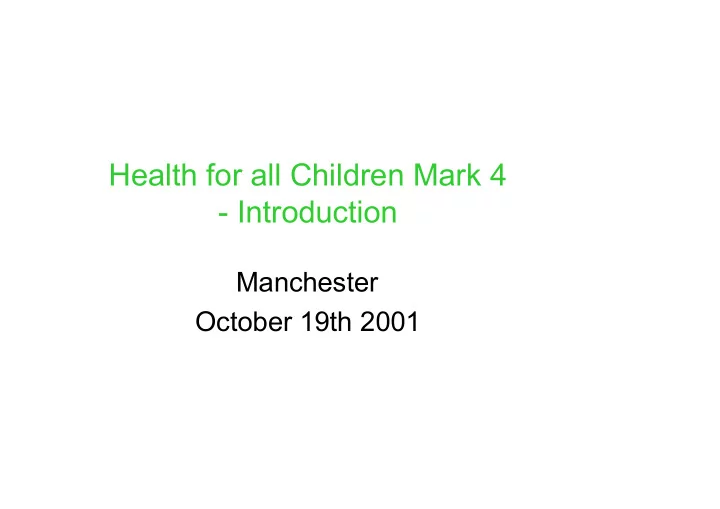

Health for all Children Mark 4 - Introduction Manchester October 19th 2001
Child Health Surveillance (CHS) ¥ The oversight of the physical, social, and emotional health and development of children. It is initiated by professionals, is synonymous with secondary prevention and includes some screening tests.
Child Health Promotion (CHP) ¥ Any activity designed to improve physical or mental health, or prevent disease, disability and premature death of a child. It includes child health surveillance.
Health for all Children Mark 4 What we have done ¥ Multidisciplinary working party (inc. all 4 nations) with various subgroups ¥ Reviews of the relevant literature ¥ Consultation with interested parties ¥ Draft recommendations prepared
Health for all Children Mark 4 What we are doing ¥ This meeting - part presentation & part consultation - ample time for discussion
Health for all Children Mark 4 What we will do ¥ Consolidate recommendations in consultation with interested parties ¥ Produce draft report ¥ Seek views ¥ Produce final report which will form part of the NSF for children
Health for all Children Mark 4 - the Screening Component Manchester October 19th 2001
Screening - a definition ¥ ÔThe systematic application of a test or enquiry, to identify individuals at sufficient risk to benefit from further investigation or direct preventive action, amongst persons who have not sought medical attention on account of symptoms of that disorder.Õ ¥ from Wald, 1994. Quoted in Peckham & Dezateux,1998.
Screening Programmes ¥ Include not just the screening test, but also Ð Diagnostic tests Ð Counselling Ð Treatment ¥ Screening tests are Ð Population based Ð Not diagnostic Ð Based on risk reduction
National Screening Committee ¥ Previously drift, lack of control and lack of equity (Ôpostcode screeningÕ) ¥ NSC set up 1996 ¥ Remit - to advise Minister on screening policy ¥ Wide representation, including patient representation and from 4 nations ¥ Child Health Subgroup set up 1998
Approval of Screening Programmes - The Process ¥ Raised as an issue ¥ All the available data gathered, ideally including a systematic review ¥ Meeting of specialists and generalists to discuss evidence ¥ CHSG considers ¥ NSC recommends to ÉÉÉÉ. Minister
Screening programmes criteria to be met -1 ¥ The condition Ð Important health problem Ð Natural history known Ð Recognisable presympomatic stage
Screening programmes criteria to be met - 2 ¥ The test Ð Simple Ð Safe Ð Reliable Ð Inexpensive Ð Acceptable
Screening programmes criteria to be met - 3 ¥ The test (cont.) Ð Distribution of test values known with agreed cut-off Ð Agreed policy for diagnostic process in screen positive individuals. Ð Benefits should outweigh risks.
Screening programmes criteria to be met - 4 ¥ The treatment/management Ð Effective Ð Early treatment should have better outcome
Screening programmes criteria to be met - 5 ¥ The programme Ð Clinically, socially and ethically acceptable Ð Equity of access Ð Cost-effective Ð Managed and monitored within a QA framework
NSC recommendations on screening for biochemical disorders ¥ PKU and hypothyroidism to continue. ¥ Set up a programme centre. ¥ Screening for other IEM not currently justified - more work to be done particularly on MCADD.
NSC recommendations on postnatal screening for haemoglobinopathies ¥ Screen postnatally for sickle cell disorders Ð implementation group in place
NSC recommendations on postnatal screening for cystic fibrosis ¥ Screening postnatally for cystic fibrosis disorders cannot be justified on current evidence which is finely balanced ¥ As a significant number of babies are already being screened, the Minister has decided that postnatal screening will be introduced
NSC recommendations on screening for hearing loss ¥ Universal neonatal hearing screening ¥ Abandon routine infant distraction test once the above is in place ¥ School entry sweep to continue for the present
NSC recommendations on screening for DDH/CDH ¥ Clinical examination of all babies within first week and again at 4-6 (6-8) weeks. ¥ Ultrasound on all with clinical abnormality. ¥ Ultrasound on all with certain risk factors.
NSC recommendations on screening for visual disorders ¥ Clinical examination at birth and again at 4-6 (6-8) weeks. ¥ Orthoptic assessment between 4 and 5 years old. ¥ Cease testing at 7 years old ¥ Other school programmes to continue pro tem
NSC recommendations on screening for growth disorders ¥ Measurement and plotting of weight at routine contacts in infants and young children is considered Ôgood practiceÕ ¥ Measure and plot height and weight at school entry. ¥ No other measurements can be justified as screening measures
NSC recommendations on screening for behaviour and development ¥ No procedures satisfy the criteria for a screening test - lack either sensitivity or specificity ¥ CHAT for autism - results published and authors suggest should not be used as a screening test, but more awareness needed
Health for all Children Mark 4 ¥ Increasing evidence to support non- screening activities ¥ Immunisation ¥ Some school health activities ¥ Health visiting
Domiciliary Health Visiting A systematic review ¥ Limitations Ð Mostly N. American studies Ð Often high risk populations Ð Mostly small studies Ð Often not randomised Elkan R 2000
Domiciliary Health Visiting A systematic review Effectiveness demonstrated in (1) ! Improved parenting skills ! Amelioration of behaviour problems ! Improved development ! Increased immunisation uptake ! Reduced use of emergency services Elkan R 2000
Domiciliary Health Visiting A systematic review Effectiveness demonstrated in (2) ! Reduced unintentional injury ! Improved detection and management of PND ! Enhanced quality of social support to mothers ! Improved breastfeeding rates ! Initiatives limiting family size Elkan R 2000
Health for all Children Mark 4 -Who does what ¥ Doctors v Nurses ¥ Midwives v Health Visitors ¥ Health Visitors v School Nurses ¥ Professional v Lay ¥ Competencies rather than job title
Recommend
More recommend